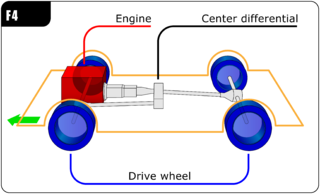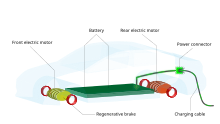
Four-wheel drive, also called 4×4 or 4WD, refers to a two-axled vehicle drivetrain capable of providing torque to all of its wheels simultaneously. It may be full-time or on-demand, and is typically linked via a transfer case providing an additional output drive shaft and, in many instances, additional gear ranges.

The Audi A3 is a subcompact executive/small family car (C-segment) manufactured and marketed by the German automaker Audi AG since September 1996, currently in its fourth generation.
The powertrain layout of a motorised vehicle such as a car is often defined by the location of the engine or motors and the drive wheels.

The Audi e-tron is a series of electric and hybrid cars shown by Audi from 2009 onwards. In 2012 Audi unveiled a plug-in hybrid version, the A3 Sportback e-tron, released to retail customers in Europe in August 2014, and slated for the U.S. in 2015. A decade after the unveiling of the first e-tron concept at the 2009 International Motor Show Germany, Audi's first fully electric e-tron SUV went into production in 2019.

In automotive design, an F4, or front-engine, four-wheel drive (4WD) layout places the internal combustion engine at the front of the vehicle and drives all four roadwheels. This layout is typically chosen for better control on many surfaces, and is an important part of rally racing, as well as off-road driving. In terms of racing purposes, whether it be on-road or off-road, can be described as follows,
A team that pursues the Weak LS4WD architecture will minimize the development cost of the front-wheel drive system at the expense of having a larger rear powertrain. The Weak architecture produces a vehicle with a large powersplit between the front and rear powertrains, while the Strong architecture recommends a vehicle with more similar power and torque requirements for the front and rear.

Audi hybrid vehicles are hybrid electric vehicles created by the German carmaker, Audi. Some vehicles listed were concept vehicles, which utilised an internal combustion engine and an electric motor, and were used for research and development (R&D) for potential future use of the technology into possible series production. Audi launched its first hybrid concept car in 1989 called the Audi Duo, and was the first European company to sell a hybrid in 1997, though only in very small numbers.

Individual-wheel drive (IWD) is a wheeled vehicle with a drivetrain that allows all wheels to receive torque from several motors independent of each other. The term was coined to identify those electric vehicles whereby each wheel is driven by its own individual electric motor, as opposed to conventional differentials.
Torque vectoring is a technology employed in automobile differentials that has the ability to vary the torque to each half-shaft with an electronic system; or in rail vehicles which achieve the same using individually motored wheels. This method of power transfer has recently become popular in all-wheel drive vehicles. Some newer front-wheel drive vehicles also have a basic torque vectoring differential. As technology in the automotive industry improves, more vehicles are equipped with torque vectoring differentials. This allows for the wheels to grip the road for better launch and handling.

A drivetrain is the group of components that deliver mechanical power from the prime mover to the driven components. In automotive engineering, the drivetrain is the components of a motor vehicle that deliver power to the drive wheels. This excludes the engine or motor that generates the power. In marine applications, the drive shaft will drive a propeller, thruster, or waterjet rather than a drive axle, while the actual engine might be similar to an automotive engine. Other machinery, equipment and vehicles may also use a drivetrain to deliver power from the engine(s) to the driven components.

The Porsche Taycan is a battery electric saloon and shooting brake produced by German automobile manufacturer Porsche. The concept version of the Taycan, named the Porsche Mission E, debuted at the 2015 Frankfurt Motor Show. The Taycan was revealed fully production-ready at the 2019 Frankfurt Motor Show. As Porsche's first series production electric car, it is sold in several variants at different performance levels, and may spawn further derivatives in future models. More than 20,000 Taycans were delivered in 2020, its debut sale year, representing 7.4% of the total Porsche volume. A modified Taycan Turbo S is the current Formula E Safety car.

The Audi Q8 e-tron is a battery electric mid-size luxury crossover produced by Audi since 2019. The e-tron was unveiled as a concept car at the 2015 Frankfurt Motor Show. The final production version was revealed in San Francisco on 17 September 2018, publicly debuted at the 2018 Paris Motor Show, and was first delivered in May 2019. It is the company's first battery electric mass production car. The Sportback variant, a coupe style of the e-tron, entered production in 2020.

The Rivian R1T is a battery electric mid-size light duty luxury pickup truck produced by the American company Rivian. The first production R1T was manufactured in Illinois and was delivered to a customer in September 2021. The official EPA range for the Rivian R1T ranges from 289–352 mi (465–566 km), depending on drivetrain, battery pack capacity and wheel size.

The Audi R8 is the first generation of the R8 sports car developed and manufactured by German automobile manufacturer Audi. Conceived in 2003 in concept form, the R8 was put into production in June 2006. The Type 42 is based on the Lamborghini Gallardo and shares its chassis and engine. Audi's parent company Volkswagen Group owns Lamborghini as well and components of both of the cars were shared mainly to save development costs. Production of the Type 42 ended in August 2015, following the introduction of the Type 4S at the 2015 Geneva Motor Show which was based on an entirely new platform.

The Audi Q4 e-tron is a battery electric compact luxury crossover SUV produced by Audi. It is based on Volkswagen Group's electric MEB platform and is the fourth fully-electric model in the Audi e-tron series after the Audi Q8 e-tron, e-tron GT and Q2L e-tron. Production began in March 2021, with the production version being unveiled in April 2021.

The Rivian R1S is an all-electric full-size off-road SUV manufactured by Rivian Automotive. Customer deliveries started in 2022. The car took nearly 10 years to develop. Depending on the configuration, it has either two or four electric motors.

The Ford Mustang Mach-E is a battery electric compact crossover SUV produced by Ford. The vehicle was introduced on November 17, 2019, and went on sale in December 2020 as a 2021 model. The vehicle is in the Mustang series, with model name Mach-E inspired by the Mach 1 variant of the first-generation Mustang. The car won the 2021 North American SUV of the Year Award.

The Volkswagen ID.4 and Volkswagen ID.5 are battery electric compact crossover SUVs produced by Volkswagen. Based on the MEB platform, the ID.4 is the second model of the Volkswagen ID. series. The production version of the ID.4 debuted in September 2020 as the first fully-electric crossover SUV under the Volkswagen brand, while the coupe-shaped variant of the ID.4 is marketed as the Volkswagen ID.5 and was revealed in November 2021.

The Mercedes-Benz EQA is a battery electric subcompact luxury crossover SUV (C-segment) produced by German luxury vehicle brand Mercedes-Benz since February 2021. It is part of the EQ family, a range vehicles expanded by 10 models in 2022. The vehicle uses the MFA2 platform, which designates C-segment and smaller-sized D-segment vehicles which use a base front-wheel drive layout.

The Baojun E300 or Baojun KiWi EV, is a battery electric city car manufactured by SAIC-GM-Wuling (SGMW) since 2017 under the Baojun brand. It is a four-seater car with two doors and a hatch at the rear.

The Wuling Hongguang Mini EV is a battery electric city car manufactured by SAIC-GM-Wuling since 2020. Retail deliveries began in China in July 2020. As of February 2023, global sales since inception have passed 1,100,000 units, and the Mini EV has become the best-selling electric car in China.

















